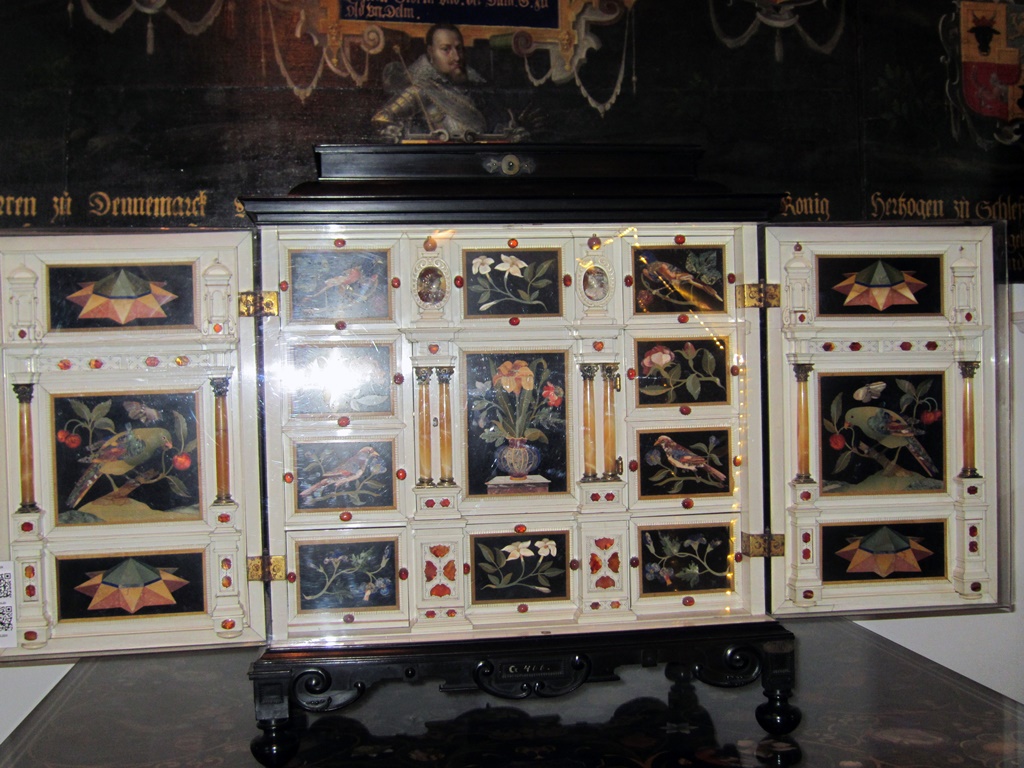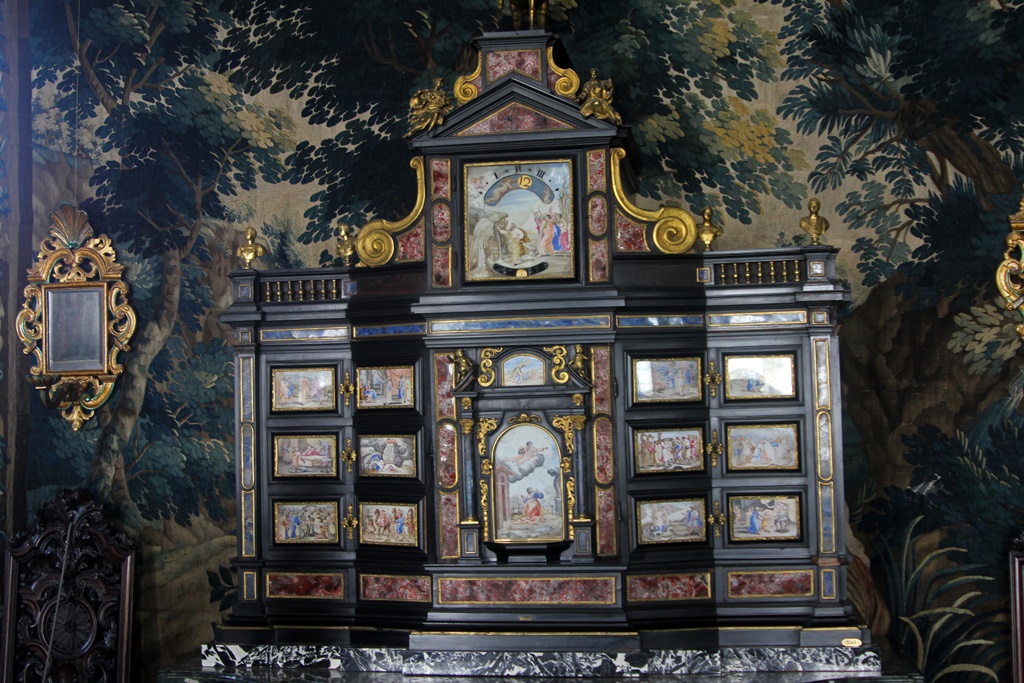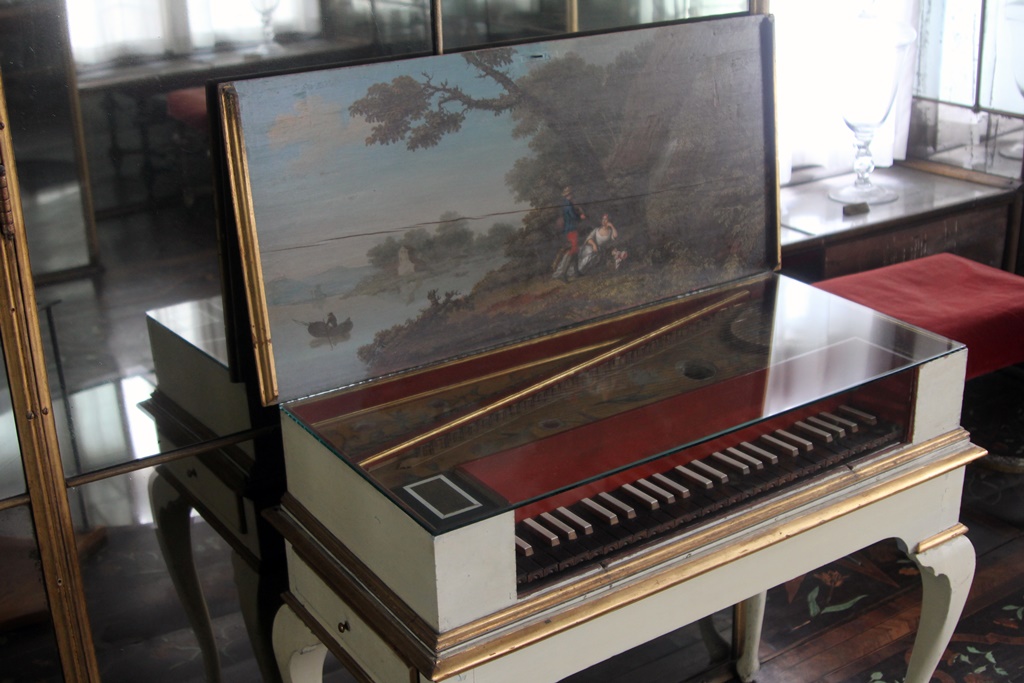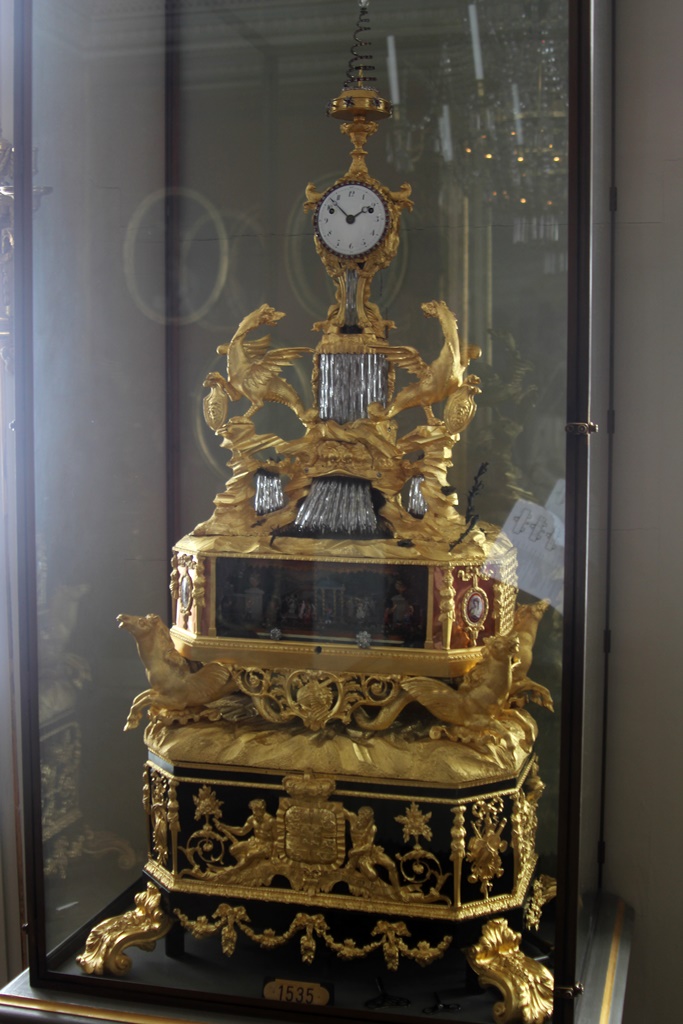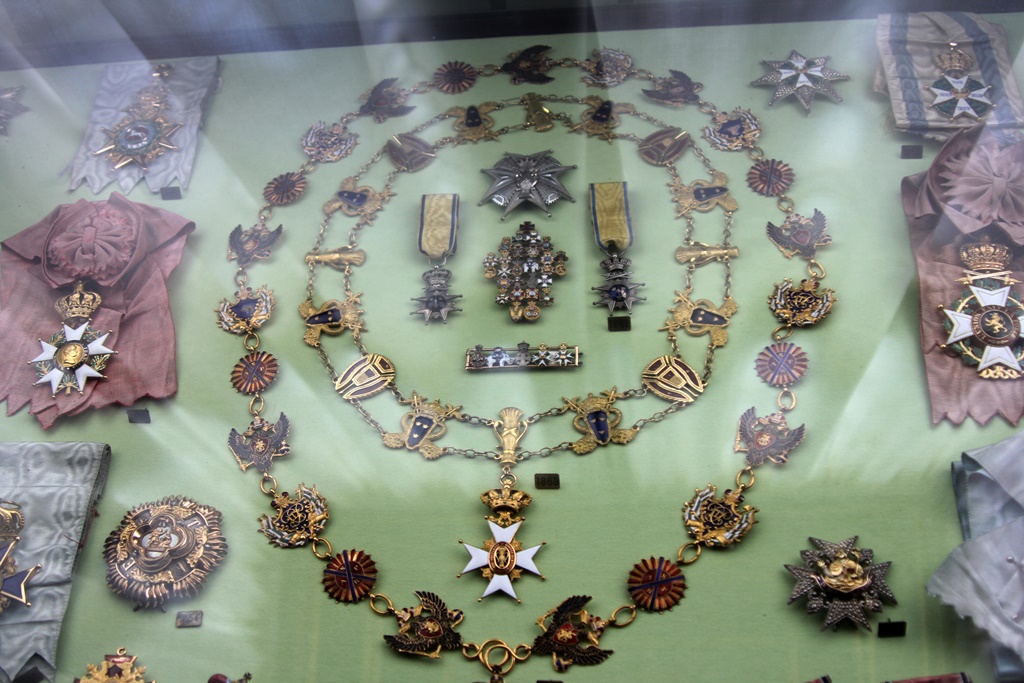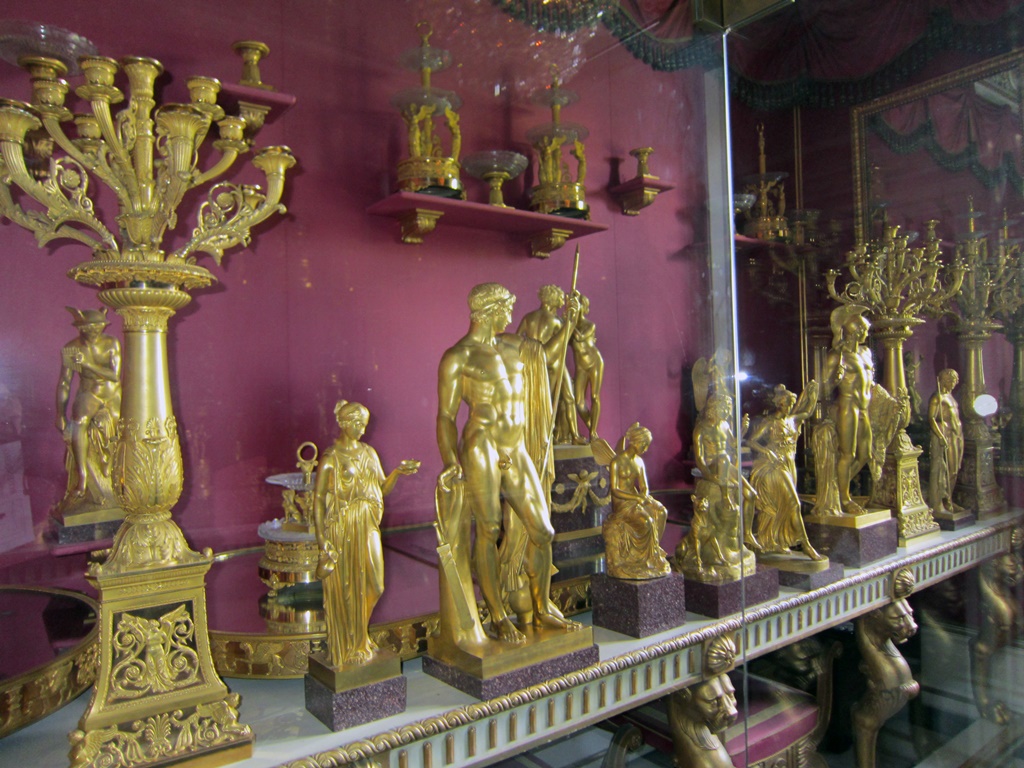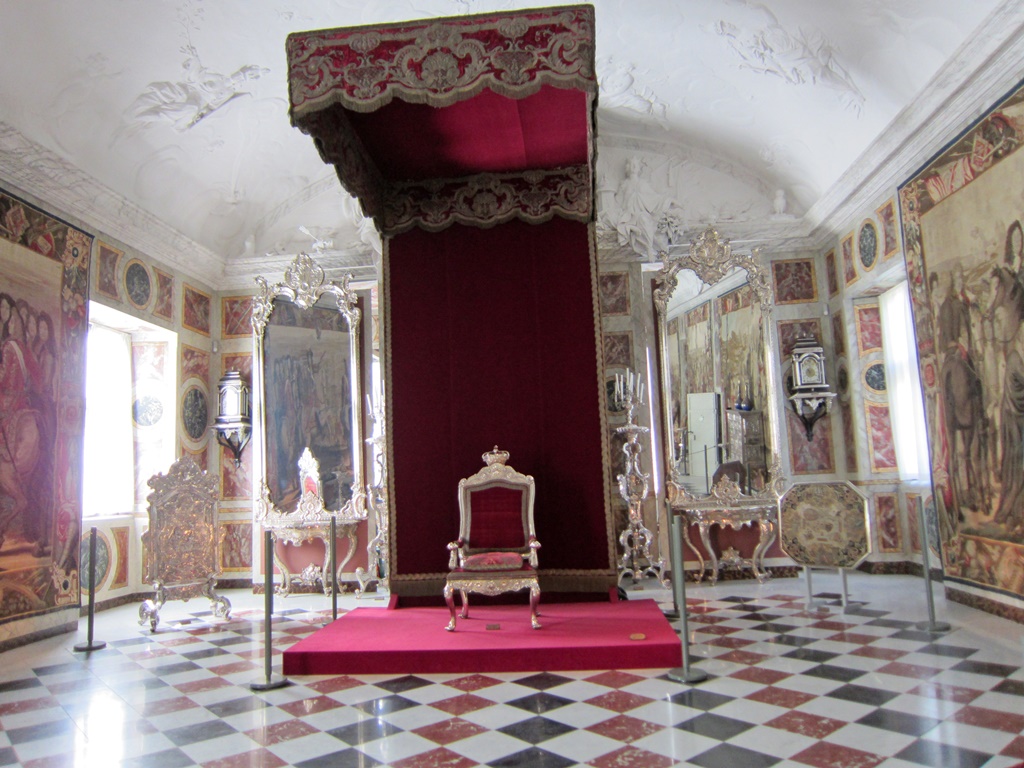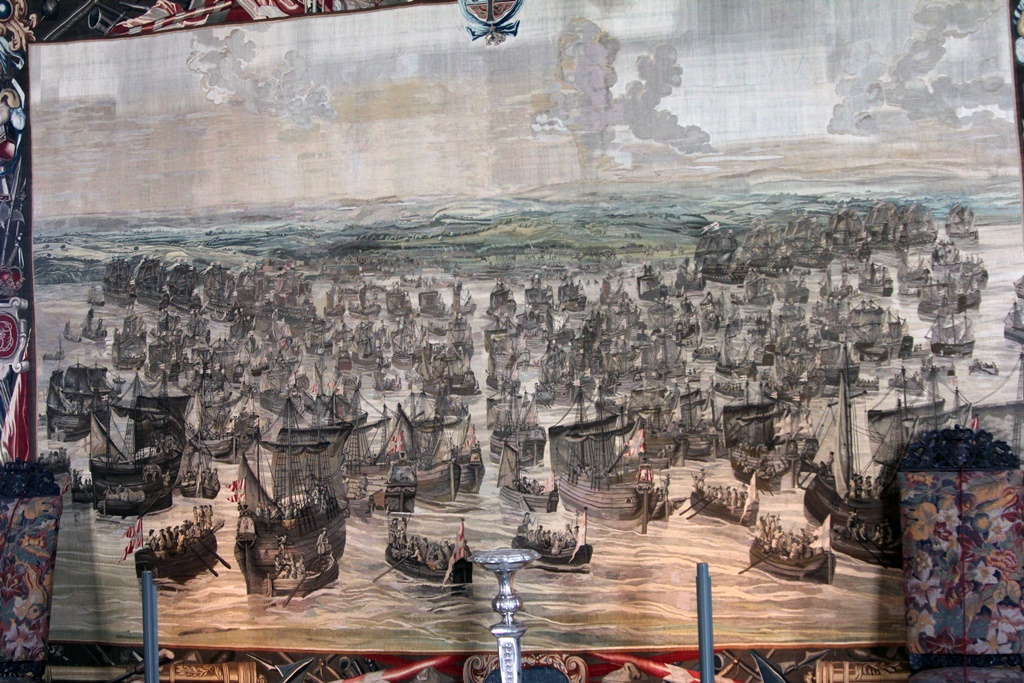Christian IV was a man of action. From early in his reign (he took power in 1596) he devoted attention to the
strengthening of Denmark’s military forces, building fortresses and more than doubling the size of the navy
(and even contributing to the design of some of the new vessels). There was a purpose to this, that being the
cementing of Danish supremacy in the Baltic Sea. This being the case, Christian involved his country in
a number of wars that involved Sweden, as Sweden was Denmark’s principal rival for Baltic power. In the last
of these wars, Christian himself, at age 66, was aboard a warship during a battle when a Swedish cannonball
caused the king to be showered with splinters and metal fragments, wounding him seriously and throwing him to
the deck. Despite his injuries (he ended up losing the sight of his right eye), he quickly bounced back up
and exhorted his crew to continue the fight ("’Tis but a scratch!"), which eventually ended in a draw. He
later had two of the metal splinters that wounded him made into earrings which he gave to his mistress.
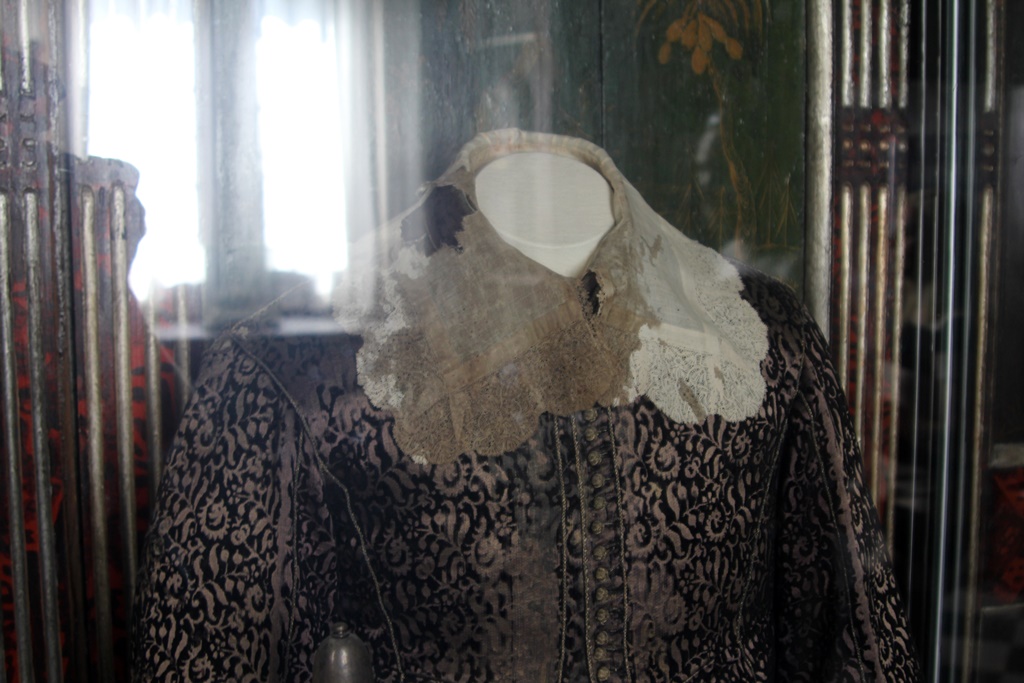
Christian IV's Blood-Stained Clothing
But in the end, Christian’s wars didn’t work out very well, largely because Sweden was better at the
alliance game than he was, and as a result Sweden ended up with Baltic supremacy instead of Denmark. But
Christian IV is nevertheless remembered as one of the most popular Danish kings. At 59 years, his
reign lasted the longest of any Danish monarch, and during this time many of his actions were
non-military. For example, he fathered 24 children (with the assistance of two wives and three
mistresses), he was a fine dancer and linguist, and he was a patron of musicians and artists. He
also liked to build things. A number of towns were established during his reign, in both Denmark
and Norway (then a Danish possession), and closer to home, he established Christianshavn (which was
named for him) and built both the Kastellet (in the present-day Little Mermaid area) and the Old
Stock Exchange (now near Christiansborg Palace). And also (and the point of all this) a structure
that came to be known as Rosenborg Castle (or
Rosenborg Slot in Danish).
Christian IV mainly lived at Frederiksborg Castle, a royal residence built by his father (Frederik
II) which was located 35 km outside the city. But he needed to stay in the city at times. A
medieval castle was located there that he could use, but he didn’t much like it. In 1606 he
acquired some land east of town and established a large park which still exists today, called
Kongens Have (The King’s Garden). The same year he began construction of a summer home in
the park. Over the years needs arose for expansions and reconfigurations, but by 1634 the structure
had pretty much become what it is today, in the process acquiring the name Rosenborg.
Nella and I bailed out of our bus near Kongens Have, a large, well-maintained park that’s surrounded
by a wall, but to which entrance is free. The park seems to be popular with the locals, many of
whom could be seen strolling or sunbathing.
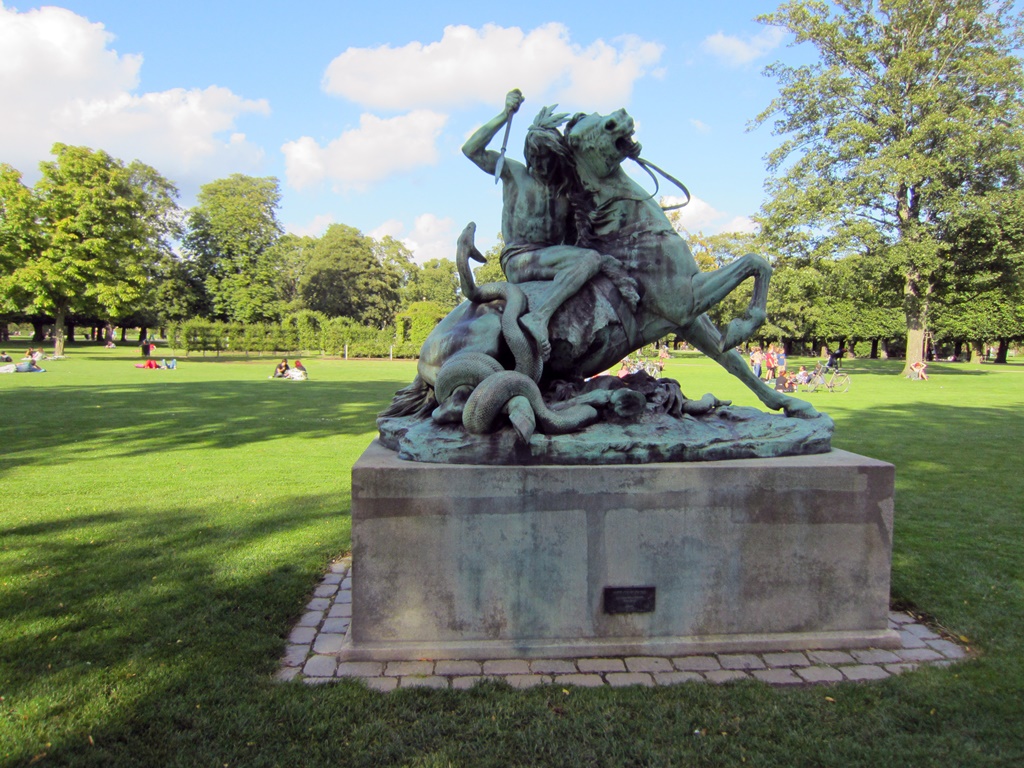
Statue at Kongens Have
We found the castle at the west end of the park. The castle was built in a style known as Dutch
Renaissance, and mostly looked to be in pretty good shape, though there was some scaffolding in
places, possibly for some maintenance work. There was a water-filled moat around the castle,
though the castle itself didn’t appear that it would work very well as a defensive fortification
(a couple of well-placed artillery shells, or even a volley of cannonballs, would probably reduce
the castle to a smoldering ruin). Tickets were sold around the back of the castle, and on going
to the ticket office we noticed the nearby garrison of the Royal Life Guards, the guys with the
big furry hats who march over to Amalienborg each day.
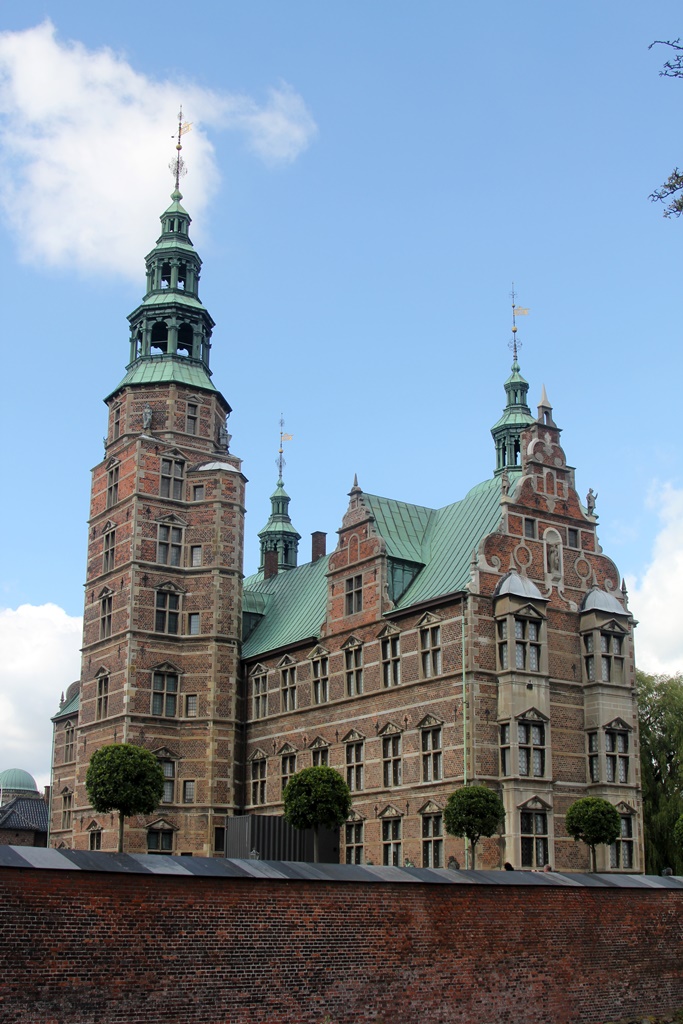
Rosenborg Castle
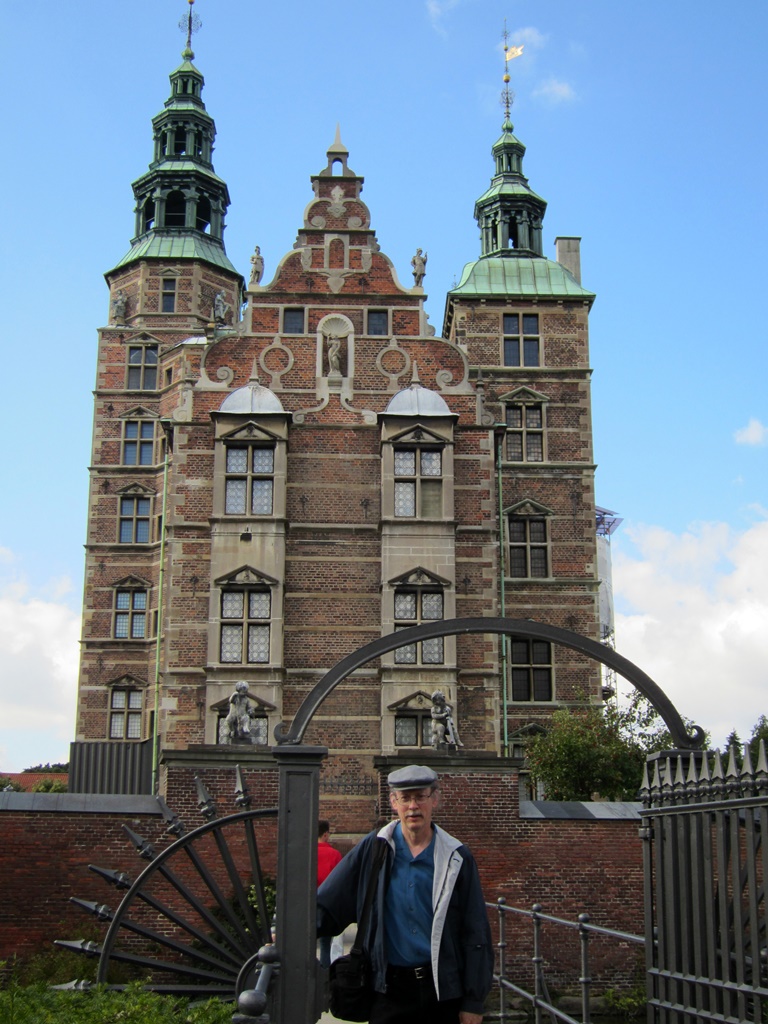
Bob and Rosenborg Castle
Rosenborg Castle and Ticket Office
As readers of this website know by now, in our travels to various places of interest, we have encountered
a variety of photographic situations. Some places let you take all the pictures you want, some let you
take still photos but no video, some outlaw photography but don’t really enforce the rule, and some are
very strict and enforce (or attempt to enforce) their no-photography rules with gusto. We’ve never quite
understood the reasons for the no-photography rules – certainly flash photography can be damaging to
artworks over time (and annoying to fellow visitors), but it seems that non-flash photography should not
be a problem in this respect (and in fact many prestigious museums are fine with it). Or maybe they feel
they would be losing revenue, as people who take their own pictures might be less likely to buy books
sold in their gift shops. At Rosenborg, the situation is handled in a way that seems to us to be
particularly civilized. People who want to take photos are allowed to, but only if they pay some extra
krones, which gets them photographic-privilege wristbands. This weeds out the non-serious photographers
who don’t really care that much about taking pictures, and opens up a new revenue stream for the
proprietors. And in our case, they made out especially well, as we ended up buying a book also.
So what is it that we wanted to take pictures of so badly? As mentioned above, Christian IV built
Rosenborg as a part-time residence. He liked it very much, and actually ended up dying there in 1648. His
successors also lived there at times, but during the reign of Christian VI, who took the throne in 1730,
Christiansborg Palace was built, and royal families no longer lived at Rosenborg, except in emergency
situations. The castle was instead repurposed as a repository for royal stuff. We wanted to take pictures
of the stuff. And we did.
The Castle has four floors we were free to explore – three above ground, and one below. A visitor route
took us through a succession of rooms that were mainly devoted to Danish monarchs, mainly in chronological
order. The first, naturally, were devoted to Christian IV, beginning with his study.
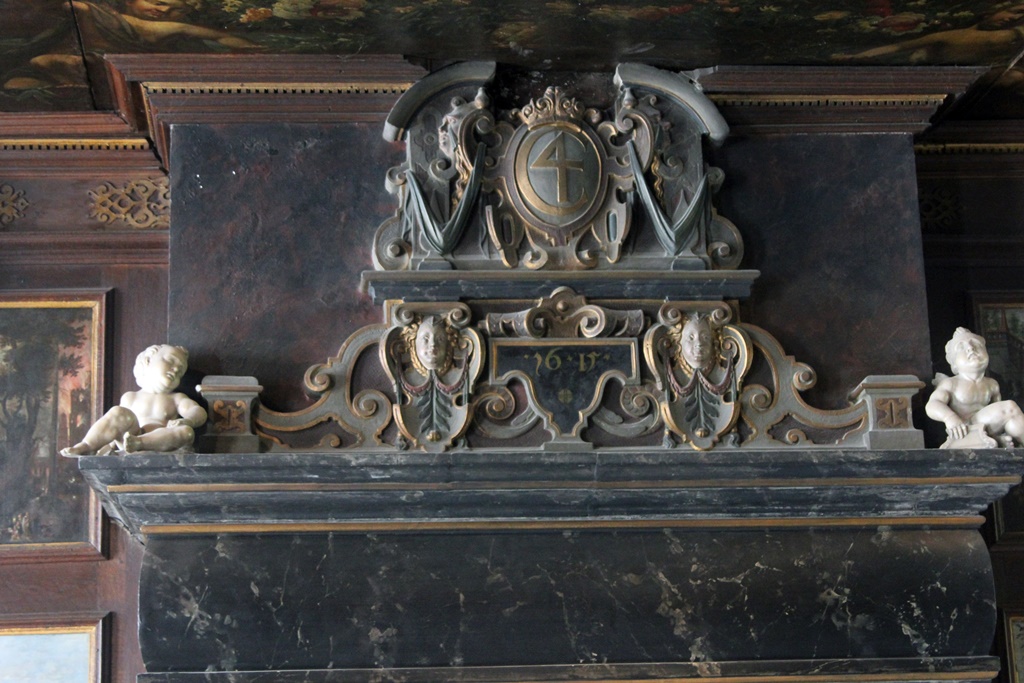
Mantel, Christian IV's Study

Equestrian Figure of Christian IV (1598)

Portraits of Christian IV and Queen Sophie
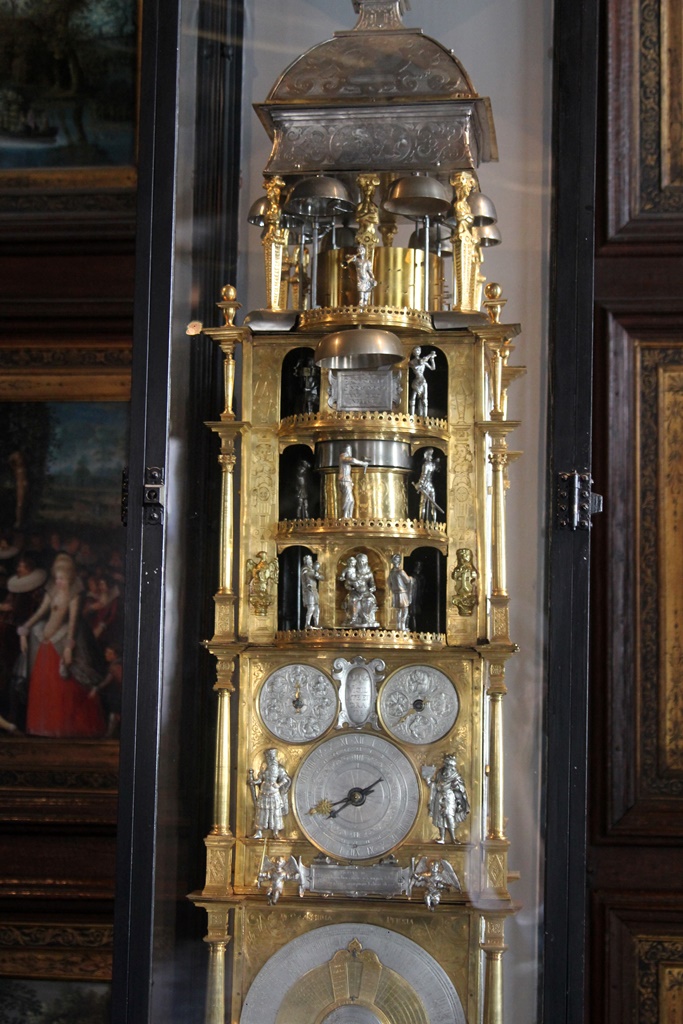
Astronomical Clock (1594)

Writing Desk with Hercules Reliefs

Painting of Picnic
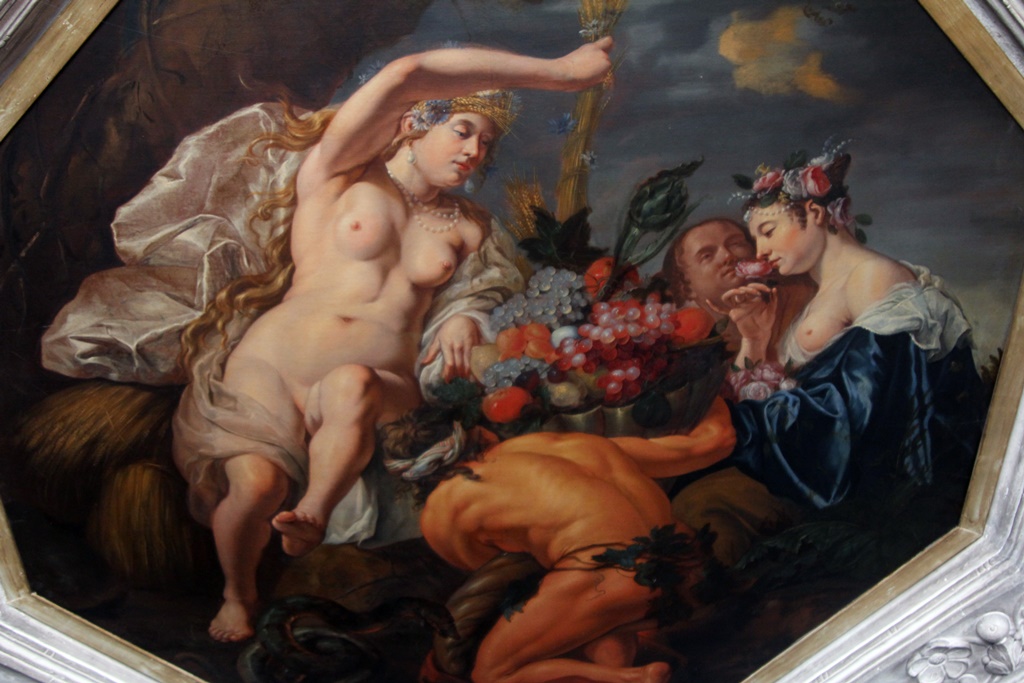
Ceiling Painting - The Feast of the Gods

Ivory Model of Rosenborg
After leaving the Christian IV rooms, we came across a couple of rather creepy artifacts, life-size
wax figures of Christian’s son, Frederik III, and his wife, Sophie Amalie, peering out from
cabinets. Apparently this was a fashionable thing to do in the 17th Century, pre-dating Madame
Tussaud by more than 100 years.
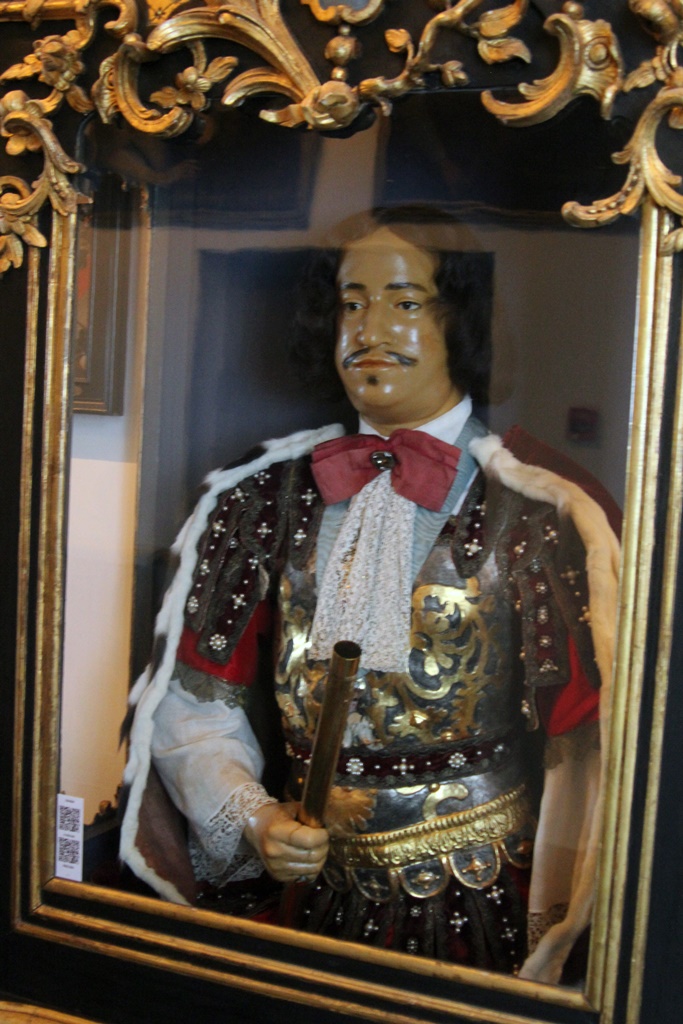
Frederik III
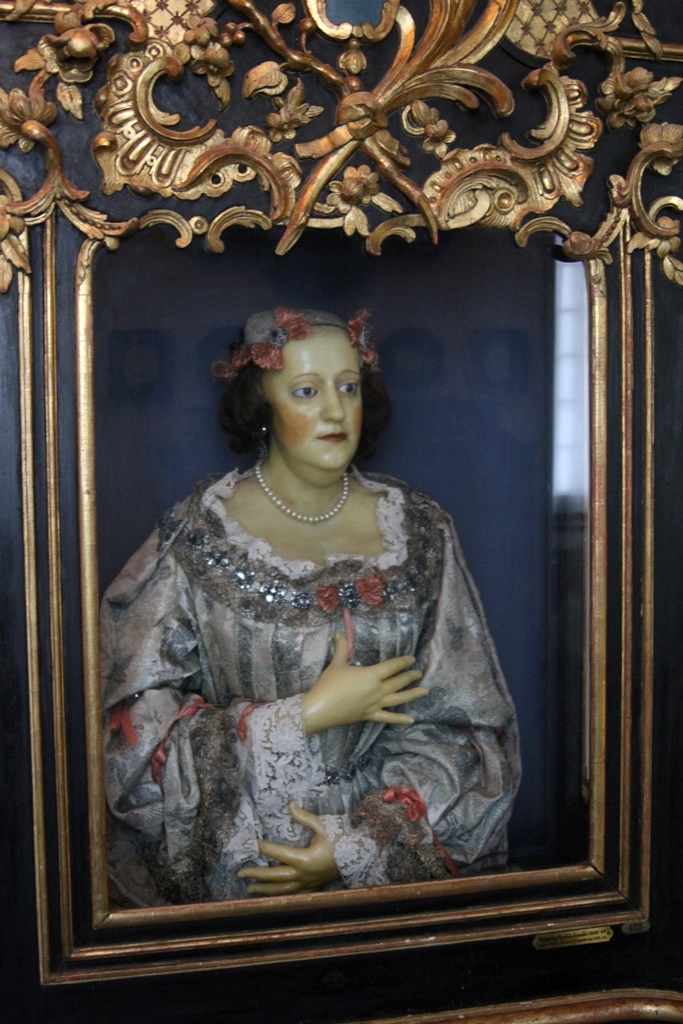
Sophie Amalie
Jewel Cabinet (ca. 1650)
We didn’t get many good pictures of stuff devoted to Frederik’s successor, Christian V, but here are some
things belonging to his wife, Charlotte Amalie, and their daughter, Sophie Hedevig:
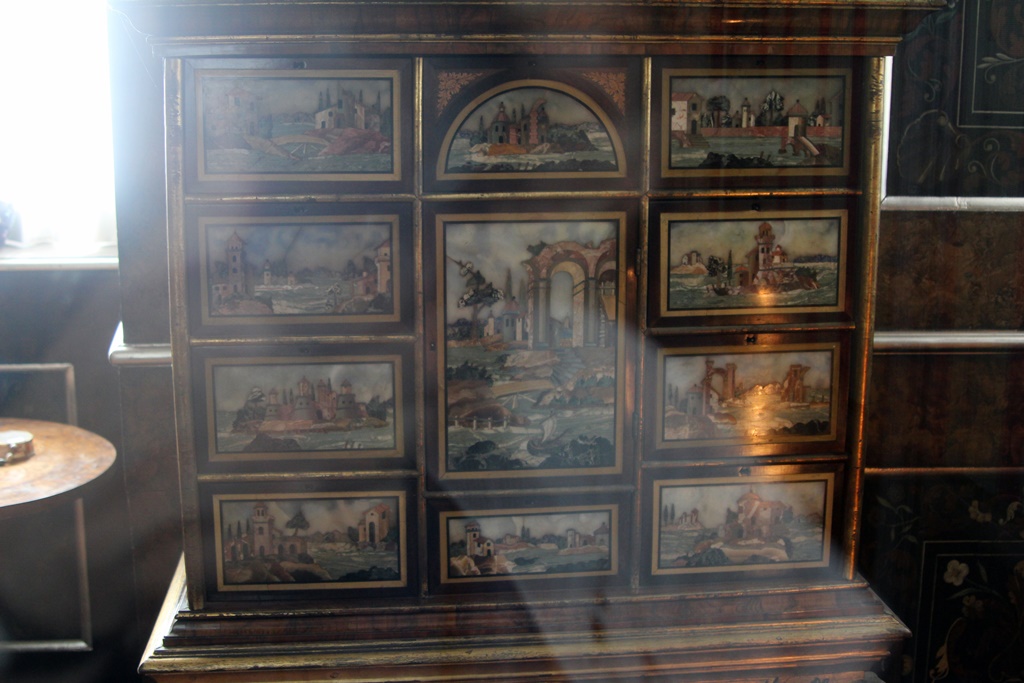
Cabinet of Charlotte Amalie (ca. 1709)
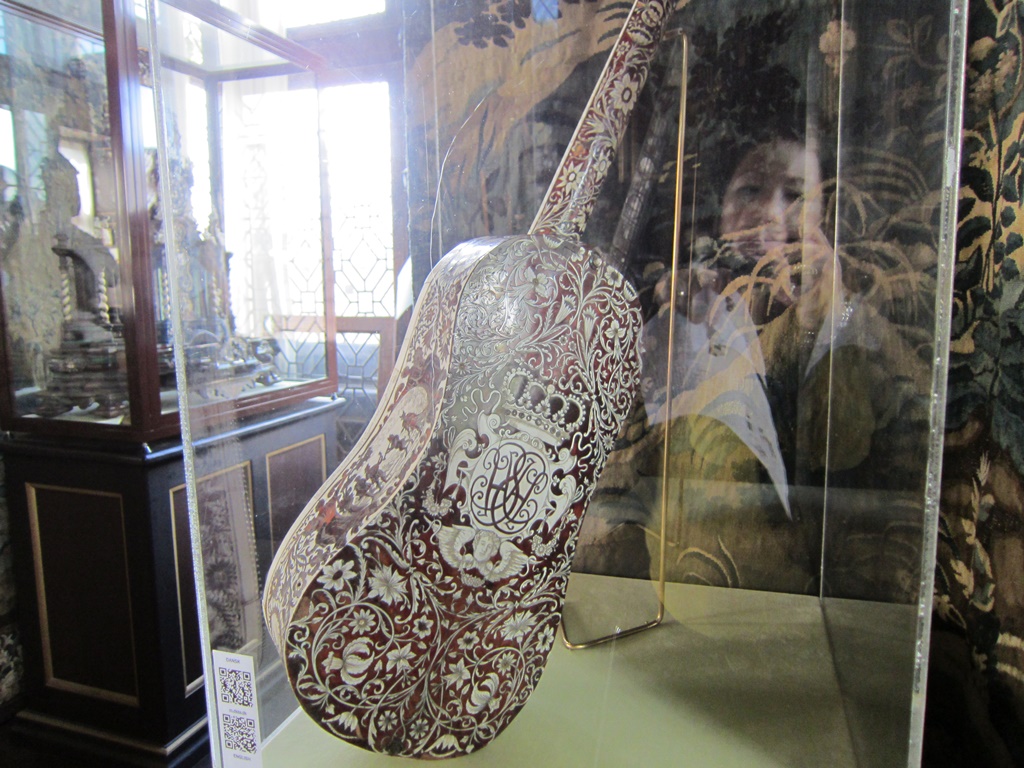
Sophie Hedevig's Guitar (1703)
The next in line was Frederik IV. Frederik held public audiences, making for an unusually open
government. He also seemed to like nice stuff.
Italian Cabinet (ca. 1700)
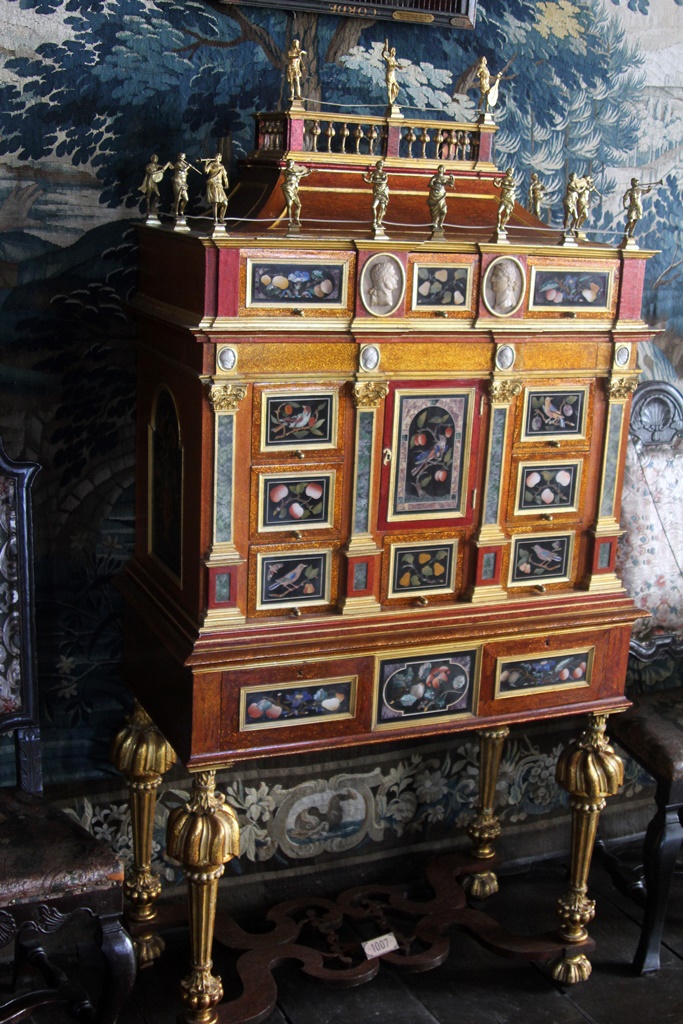
Cabinet with Bird Panels
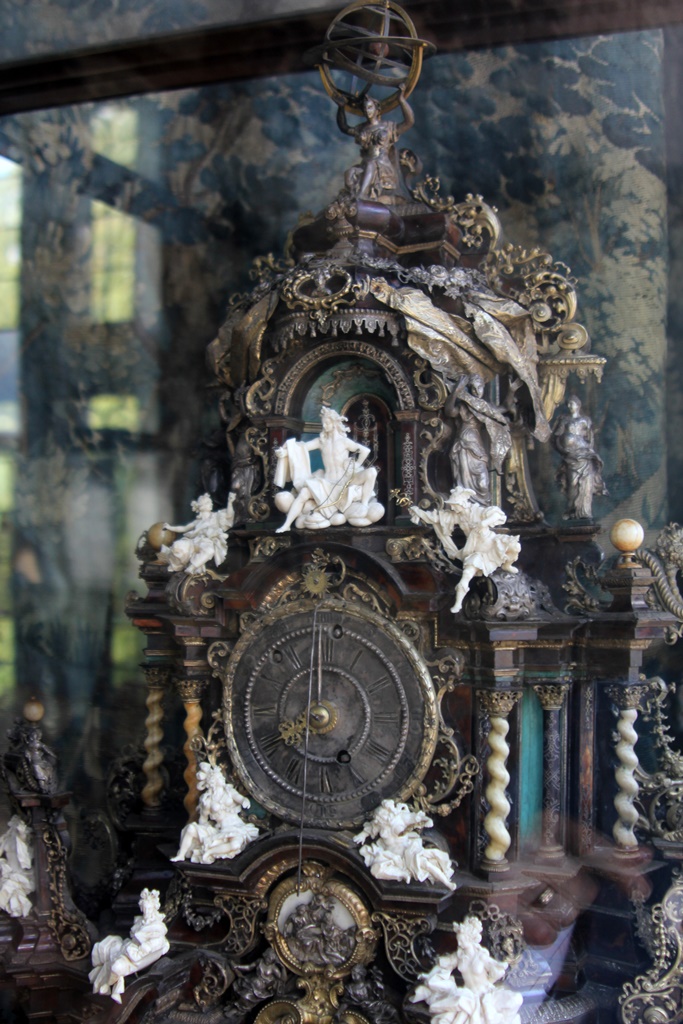
Clock with Ivory Figures

Clock

Tapestry and Clock (ca. 1715)
Next was a room devoted to Christian VI. Christian was extremely religious, and not so much into
interacting with his subjects. But his was the first reign in a long time during which Denmark wasn’t
at war with anyone. Christiansborg Palace was also built under Christian VI.
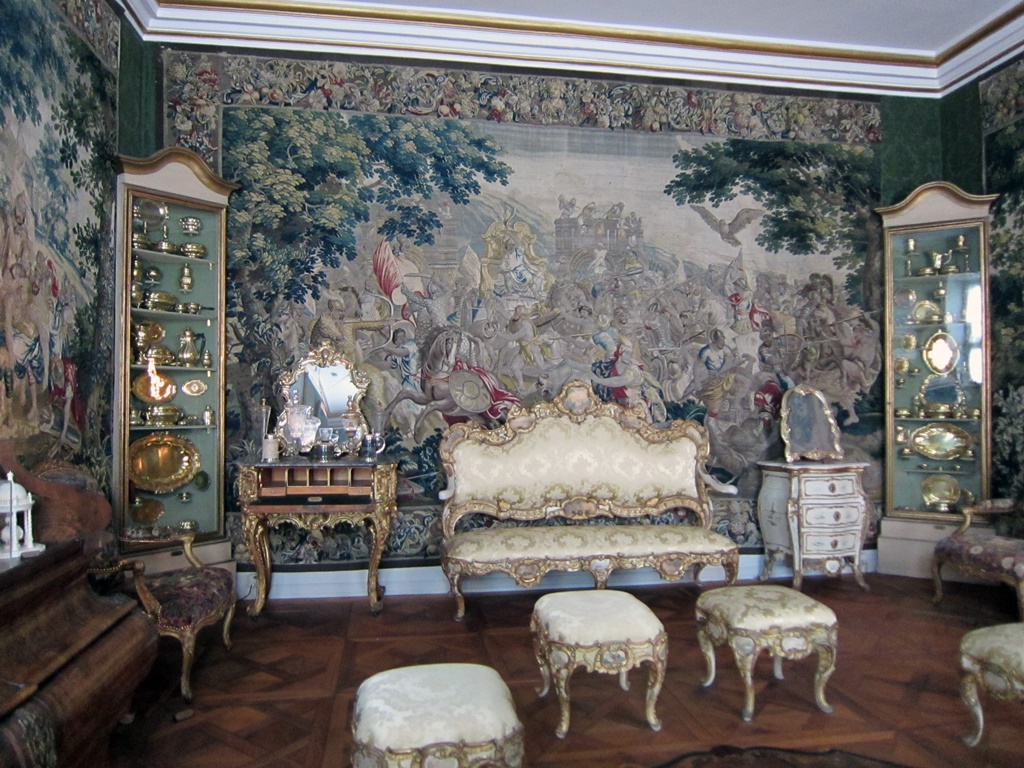
Christian VI's Room
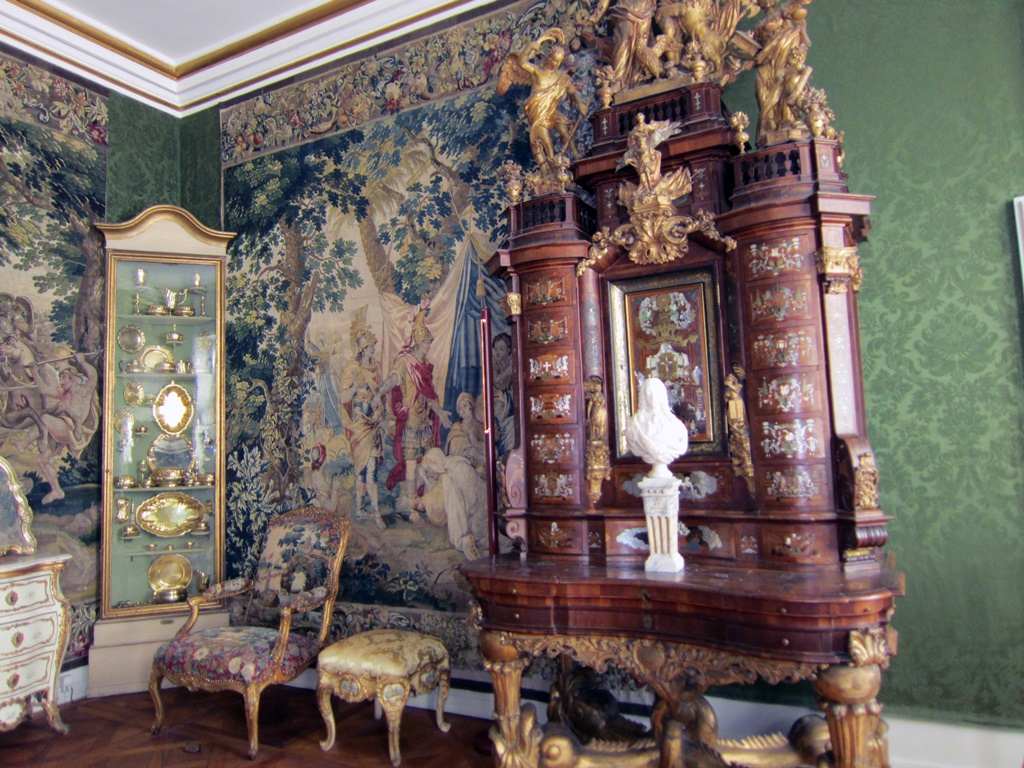
Cabinets and Tapestry

Cabinet Decoration
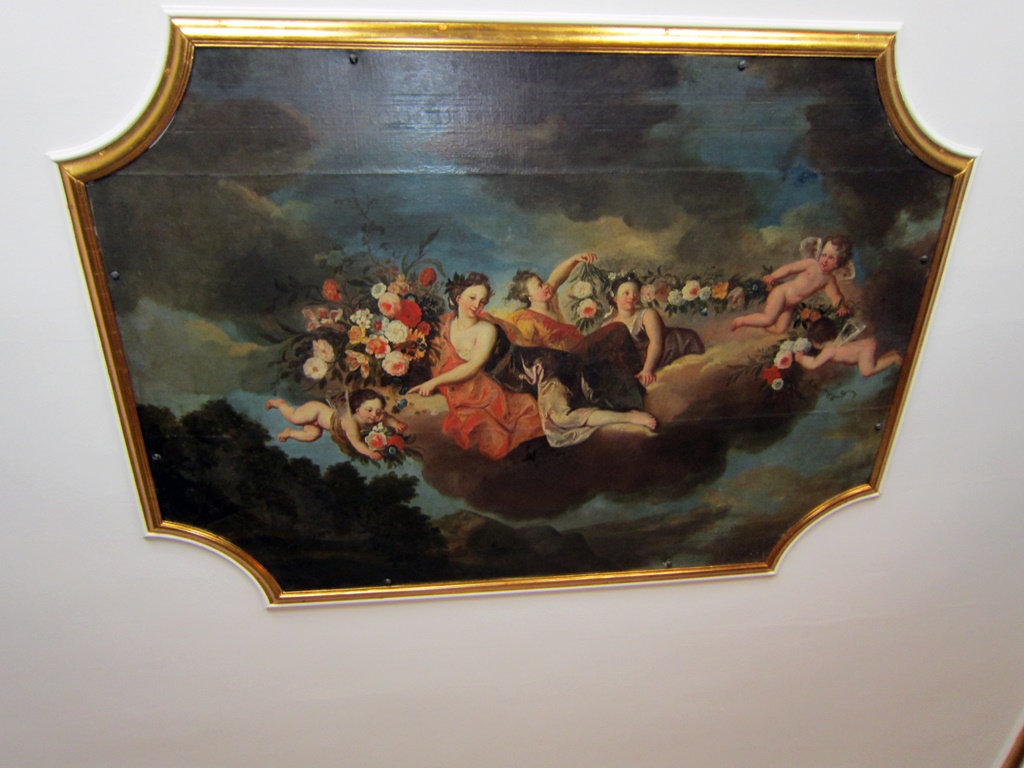
Flora, Distributing Blessing Over Denmark, Benoît le Coffre
A side room not devoted to anyone in particular was sparsely furnished, but was pretty much covered in
mirrors. It’s aptly known as the Mirror Room – it was decorated by Christian V and embellished by
Frederik IV. The room did have this instrument:
Spinet (C.F. Speer)
A nicely-tapestried room devoted to Frederik V had some especially nice things. Frederik is considered
to be one of the weaker kings, and had a problem with drinking too much. But the country was at peace
and prosperous during his reign, and Amalienborg was built during this time.
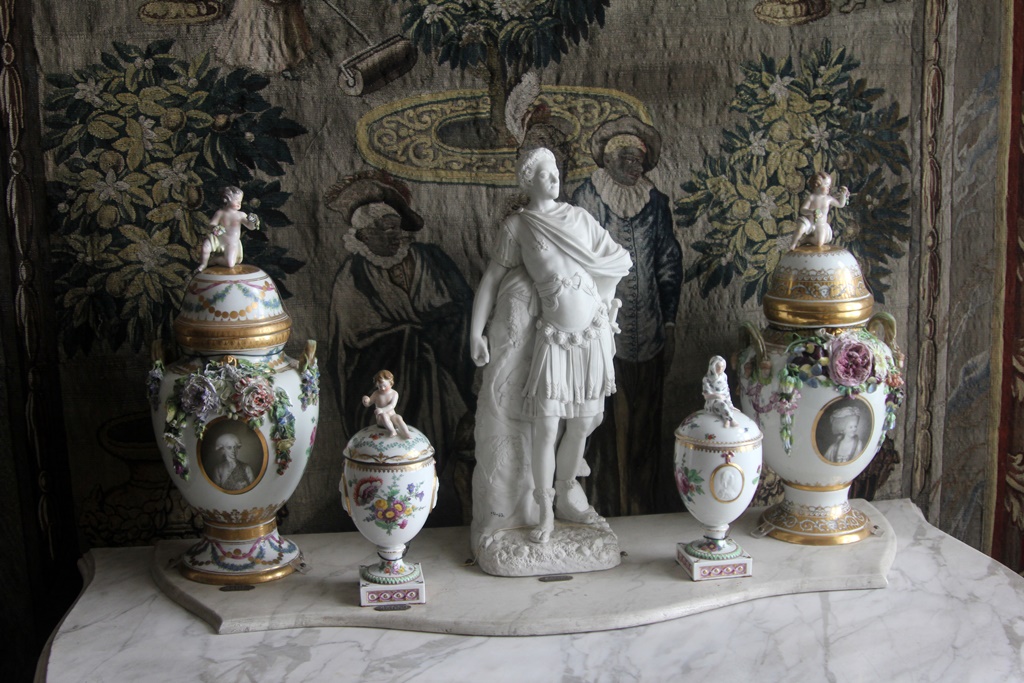
Porcelain Figures
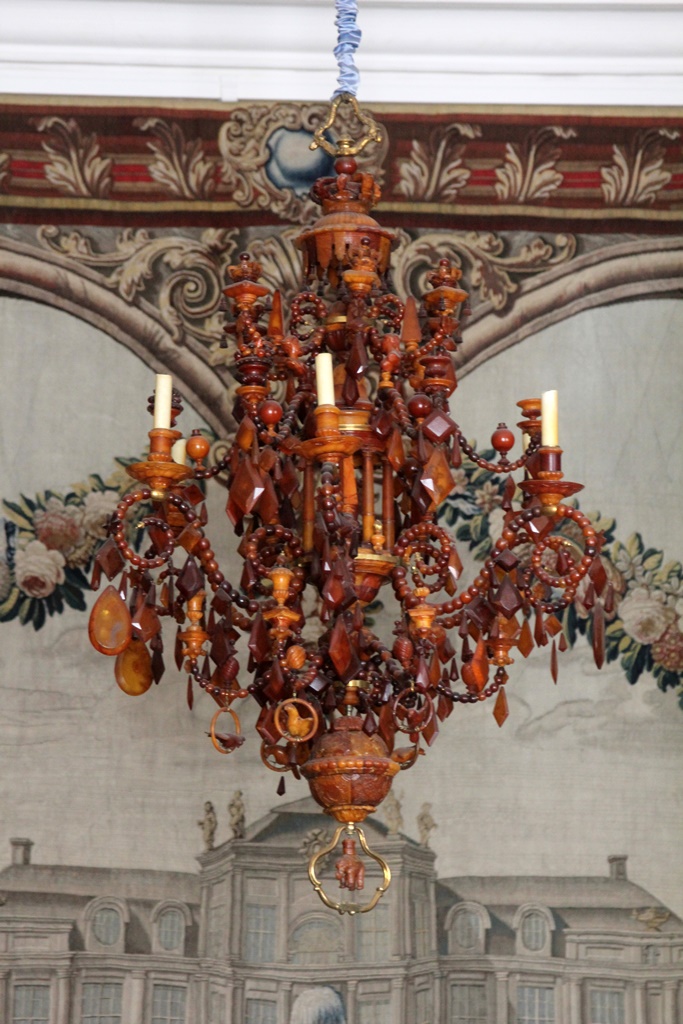
Amber Chandelier (1746-53)
More nice things were found, this time associated with Christian VII. A model of a ship made from chicken bones
by Danish prisoners during his reign was particularly unusual.
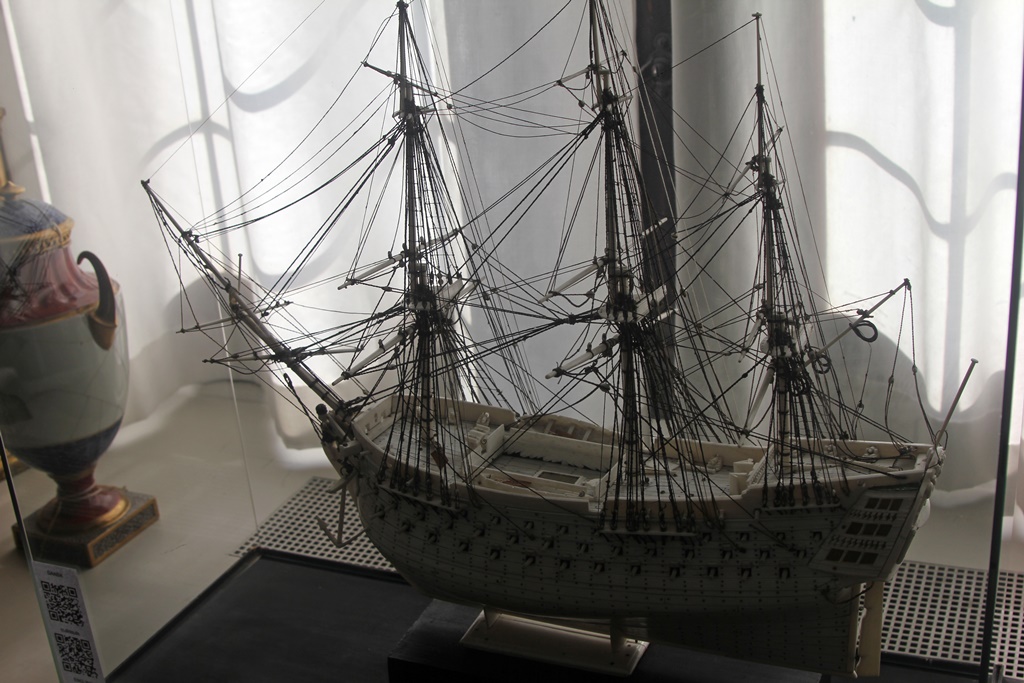
Warship Made from Bones (ca. 1807)
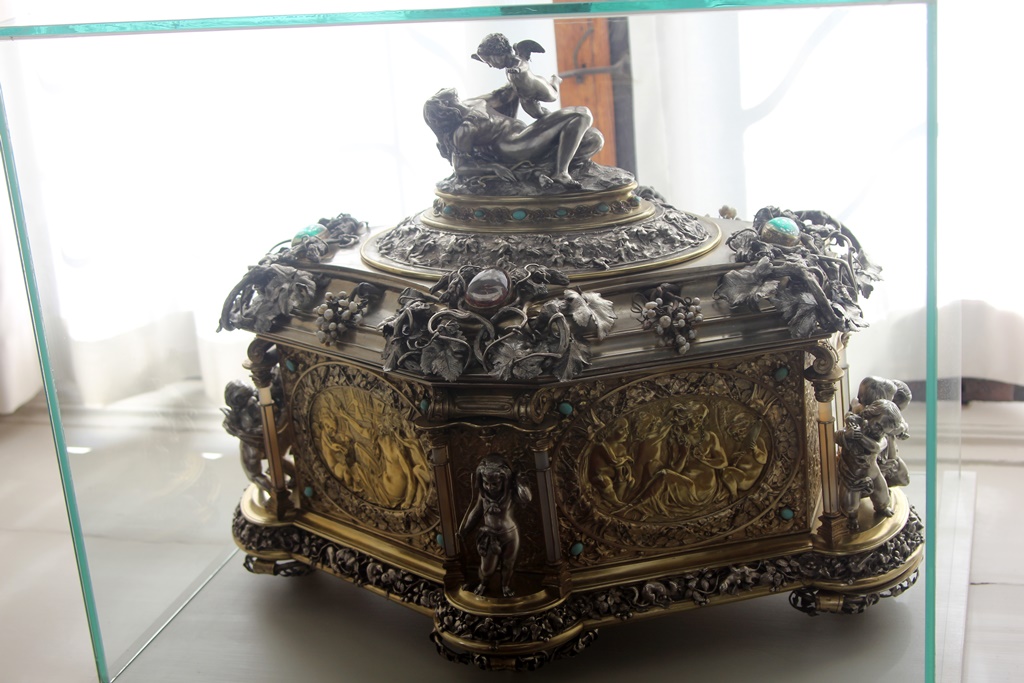
Decorated Box
Clock with Chimes, Organ and Figures (ca. 1780)
Next we found some articles associated with later monarchs:
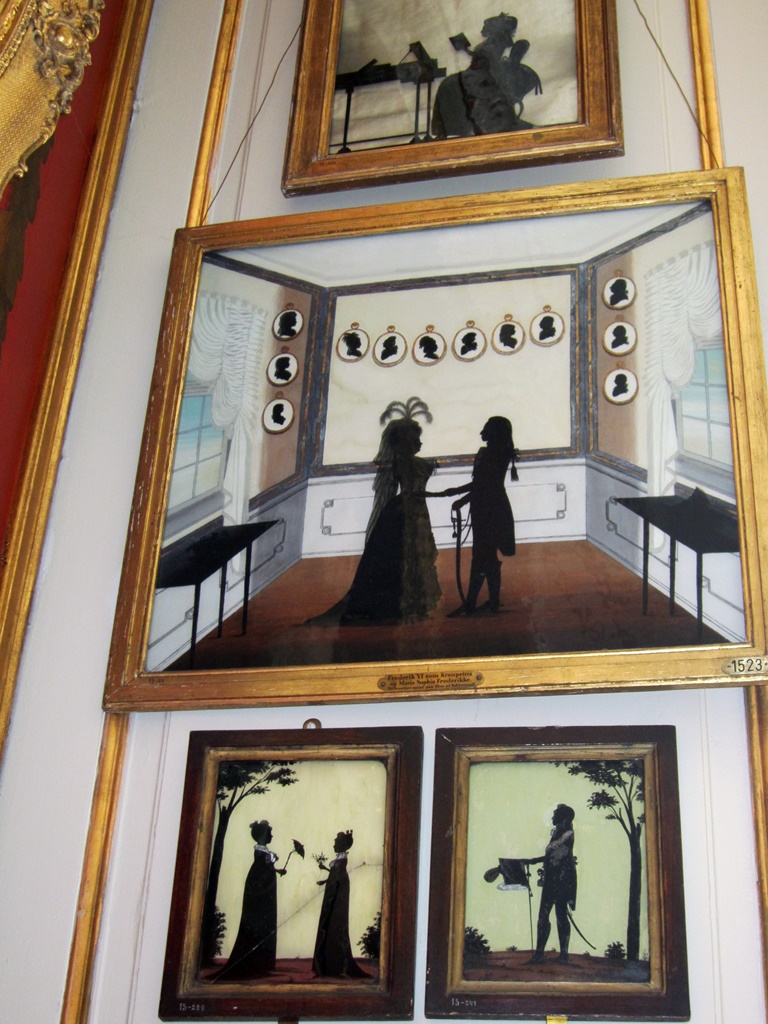
Silhouettes with Frederik VI

Bronze Clock with Christian VIII
Frederik VII's Medals
This brought us to the Bronze Room, a room dedicated to the display of a great number of artistic
objects made of bronze.
The Bronze Room
This took us to the top floor, which is mostly occupied by a long room known as The Long Room (also
called the Knights’ Hall). At either end of the room there are chairs of significance. One end
has the King’s and Queen’s coronation thrones. The King’s throne is made from narwhal tusk. Surrounding
the thrones are three silver lions which date back to the 17th Century. They are still used during
royal funerals, "standing guard" around the casket of the deceased monarch.
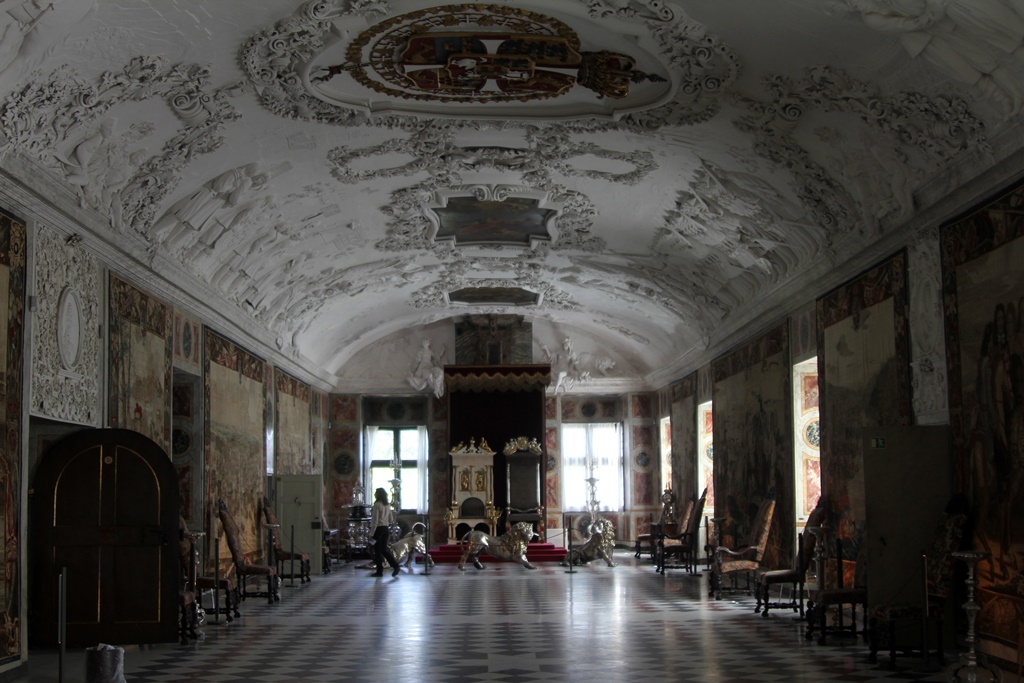
The Long Room
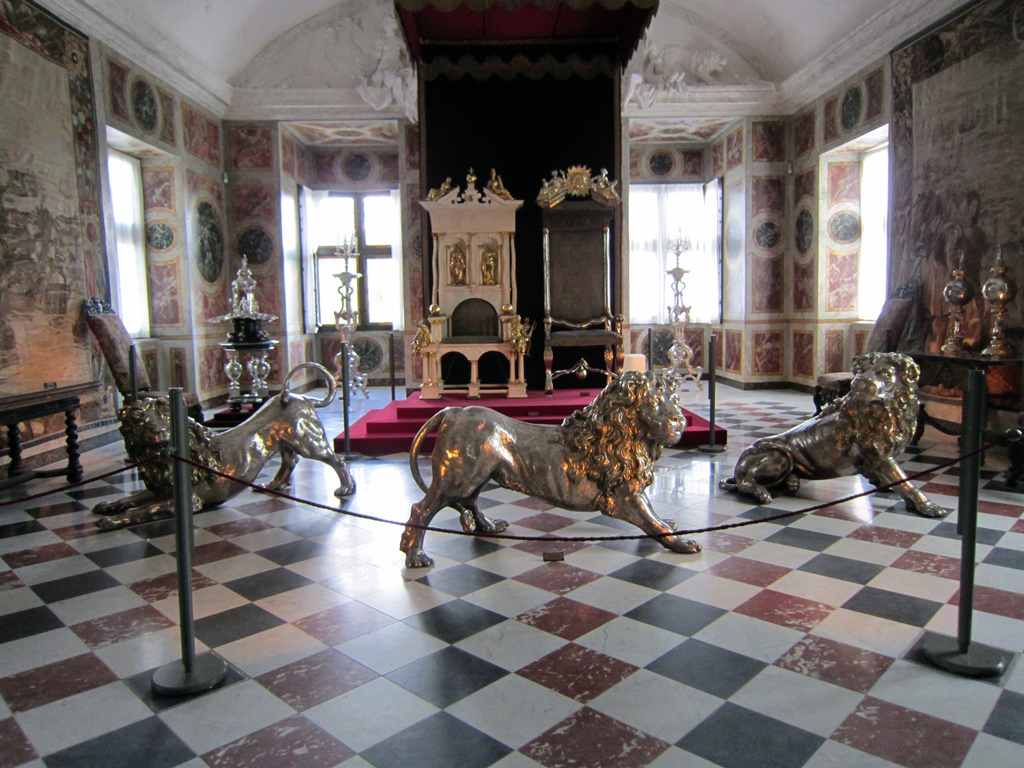
King's and Queen's Coronation Thrones with Silver Lions
At the other end of the room is the audience throne of Christian VI, which was rescued
from a fire at Christiansborg Palace in 1794.
Audience Throne of Christian VI
In between are hung tapestries depicting naval battles.
Tapestry
Also in between are doors to small rooms used to display themed collections of objects. One room holds
glass objects that were mainly made in Venice, and another has porcelain pieces, some made at what was
to become the Royal Copenhagen Porcelain Factory.
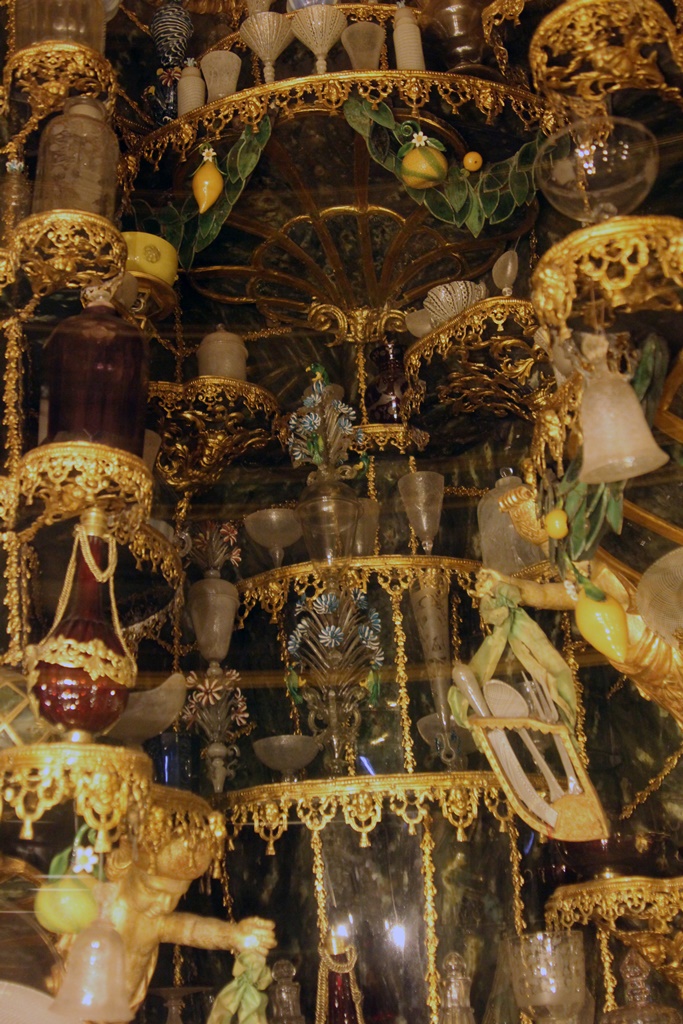
The Glass Room
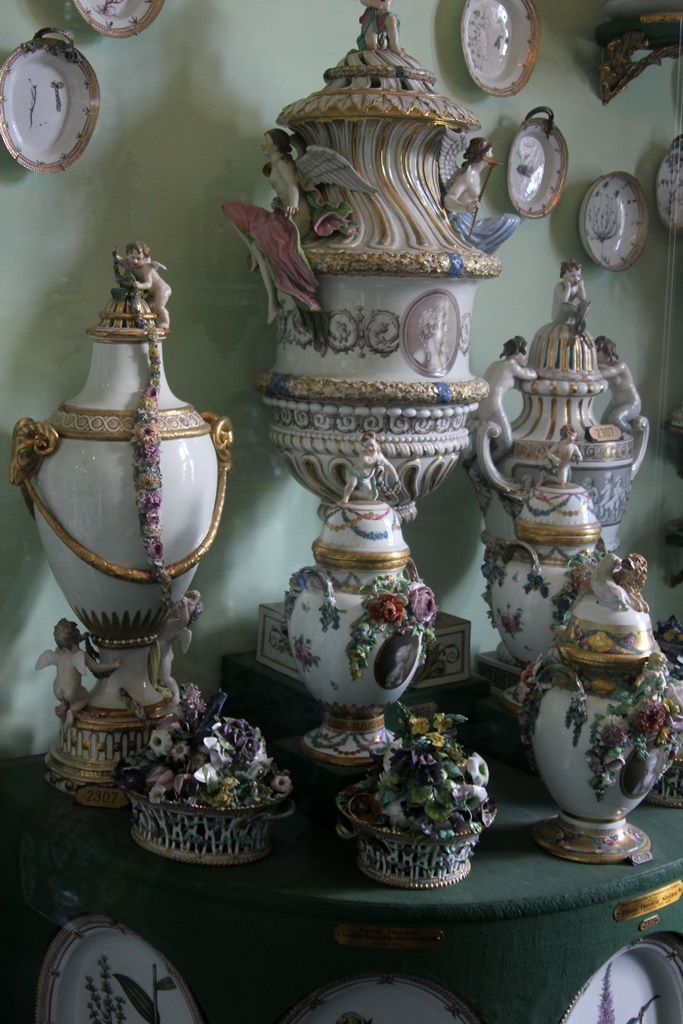
The Porcelain Room
This only left us one more floor to explore, the one that’s below the ground. I’m guessing the
objects on this floor were placed there for additional security. This is because these objects
include some of the most valuable in the country. Valuable enough to merit their own page on
bobandnellasworld.com(!). Click onward to see the Danish Crown Jewels.
















